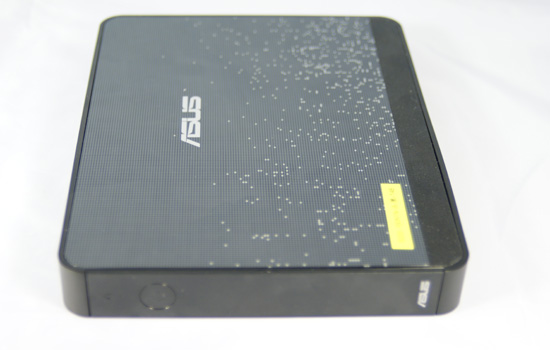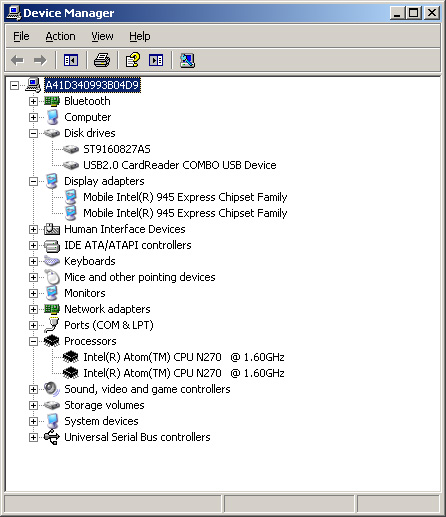ASUS Eee Box Preview & Intel's Atom Benchmarked
by Anand Lal Shimpi on June 3, 2008 12:00 AM EST- Posted in
- Systems
The Internet today is far more functional than it ever was and we’re finally at the point where being able to access the net in places like your living room, bathroom or kitchen is actually pretty useful. Recipes are no longer stored in cookbooks, they are in emails or websites. There’s a website or forum for virtually everything, not to mention the utility of sites like Wikipedia and imdb.
The problem is that a kitchen PC that could be used to check emails, look up recipes or chat with someone while cooking wasn’t really feasible when decent PCs would set you back at least $1500. As PC prices fell however, the possibility of putting a PC in nearly every room of your house increased tremendously. We’ve already established that there’s utility in such a PC-filled household, but what was left is someone to provide the hardware to make it happen.
When the One Laptop Per Child (OLPC) project was started it didn’t take long before regular computer users took notice and also wanted access to a $100 - $200 PC. It wasn’t just the end users that realized there was a need for such a machine, some of the manufacturers did too.
Before the release of the ASUS Eee PC I had dinner with ASUS’ CEO, Jonney Shih and we began talking about what was necessary to build a truly lightweight, yet functional PC. Jonney isn't your typical CEO, he's still quite an engineer at heart and enjoys discussing everything from market direction to the microprocessor architectures necessary to make that direction happen. The conversation started about the OLPC project but quickly lead to what it would take to build such a thing for the mainstream consumer market. We discussed what was possible, but little did I realize that ASUS had already begun working on such a thing.
The Eee PC was ASUS’ first attempt at a cheap machine for the masses, unfortunately as a notebook it’s a tough sell for most. The keyboard is cramped and the screen is too small to be productive on. People either loved or hated the Eee PC, but the system generated enough interest and was selling well enough that ASUS went ahead with plans to build a desktop equivalent.
Since they called the notebook the Eee PC, the desktop had to have a different name and thus it was called the Eee Box.

The Eee Box is effectively a headless notebook with no keyboard/mouse. In fact, the new version of the Eee PC features the exact same hardware configuration as the Eee Box - just in notebook form. Using notebook components in a “desktop” PC is nothing new, Apple does it all the time with the majority of its machines. The iMac uses a mobile CPU, as does the Apple TV, despite neither one being a notebook.
Stylistically, ASUS did a tremendous job with the Eee Box. The system we have here is an early prototype, the final version will be available with a solid white or black finish (the random pixel pattern on our system won’t make it to production). The machine is extremely sleek measuring 17.7 cm x 22.1 cm x 2.7 cm (6.97" x 8.7" x 1.06").
Without a keyboard or display to complain about and an even lower price tag ($269 or $299 depending on configuration), we set off to see if the Eee Box would have more universal appeal than the Eee PC.
The Configurations
There have been rumors a plenty about the standard configurations that the Eee Box would be available in and we’re finally able to give you the exact specs of the three North American models:
| OS | CPU | Memory | HDD | Price | |
| ASUS Eee Box | Linux | Intel Atom 1.6GHz | 1GB | 80GB 2.5" 5400RPM | $269 |
| ASUS Eee Box | Windows XP | Intel Atom 1.6GHz | 1GB | 80GB 2.5" 5400RPM | $299 |
| ASUS Eee Box | Linux | Intel Atom 1.6GHz | 2GB | 160GB 2.5" 5400RPM | $299 |
The base Eee Box configuration will retail for $269 and feature a 80GB SATA HDD, 1GB of memory and ship with Linux.

The same configuration with Windows XP will run you $299, or for the same amount of money you can purchase a 160GB/2GB system also with Linux. Microsoft won't allow PCs to be sold with > 80GB HDDs preloaded with Windows XP and thus the top end configuration is only available with Linux. Given our experience with the Eee Box under Vista vs. XP (which we'll get to shortly), we think that this is the perfect example of Microsoft dropping the ball and easily losing ground to open source solutions here.
All three machines will ship with the same Intel Atom processor running at 1.60GHz on ASUS’ own 945G based motherboard.
Availability is planned for July in North America although machines will first be available in Asia before then.










35 Comments
View All Comments
sprockkets - Tuesday, June 3, 2008 - link
I guess too, that I would use this computer for a 3rd system, where I just needed to use a computer if my others were in use doing cpu intensive stuff.I have a D20GLY2 for that purpose, except since it has the sis chipset, video support in linux stinks. Having an intel chipset would be great. If it were at the 965/G31 level, it would run compiz great.
Perhaps what I like about it, is that it is a small out of the way computer, good for basic tasks, for most people who need little, and would not suffer from say, the problem when one half of those computer/monitor combo went out, both are rendered useless.
Kishkumen - Tuesday, June 3, 2008 - link
Looks like it should be able to handle standard mpeg-2 based 1080i HDTV. I'll probably get one or two to use as MythTV frontends.Visual - Tuesday, June 3, 2008 - link
please re-check the pricing table that you published...you make it clear in the text after the table that the windows model should cost $299, not $269 as the table says now.
feelingshorter - Tuesday, June 3, 2008 - link
1. My parents own a small business. Due to theft, they need a working computer that i can hook up a camera up to that can capture video or images every x number of seconds. Second, they play music at their small business, so i can put MP3s on the machine (no need for high quality sound as it's just classical music). A draw back is that you need a monitor but I have a 19 inch LCD that I can pass along once i upgrade to a 24inch. Also the computer can then be locked in a "web browsing mode" or "media center mode" to allow for people to select the music and surf the web with. At the end of the day, it can be brought to the back of the business and hooked up to the camera system for surveillance (independent systems can cost a lot too but are less versatile than a PC).(At their small business, they are currently using a 5 disc CD changer, which doesn't give enough variety in music, with customers complaining about hearing the same thing over and over. Also, if you continue to play the CDs over and over again, it will overheat! Silver pressed CDs are supposed to be quite reliable but if your playing it for hours at a time, it WILL start to shudder.)
2. At less than 20watts, it will work perfectly as a machine that can be left on 24/7 (or can that not be assumed?). Anyone remember how hot some of AMD's cpu are, 2200+? A desktop that uses less power than the monitor your hooking it up to? I'll buy one just to save money on air conditioning. If not that, it will serve as a good computer in a pool room in your house. Just for our friends to surf the web while you play pool and have a beer. None of my friends really play games. We waste time on youtube and watching comedy, which this PC is powerful enough to do.
All that being said, at $270, which is really cheap already for a PC, some of us would probably rather put that money into a powerful gaming pc ($1300). Having a PC like that, in the pool room in your house for when you have guests over, is worth buying just for the small form factor and low watt usage.
3. You can also hook up a USB hard drive to it, connect the PC to a network and now you have NAS storage for all the PCs in your house.
4. This one is more for businesses. Schools and test taking centers, tutoring centers, and large corporations with stores that uses windows xp as their checkout will love this. I remember when i used to work at Hollister, their seemingly generic and custom touch screen computers they use to check customers out is actually running windows XP beneath it (you would only know if it crashed, which i saw it do and reboot) with custom software. I don't remember the cost per computer but it was ridiculously expensive for what you get (well, the store costs 11 million to open so i guess business can afford it) . This Eee PC will do the job just fine for less watts and $.
I'm also sure there are other uses but its 2 AM.
AMDJunkie - Tuesday, June 3, 2008 - link
Because the picture on the front page is always delicious irreverent and most of all, amazing.